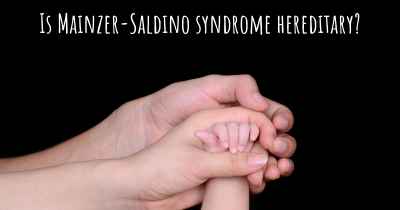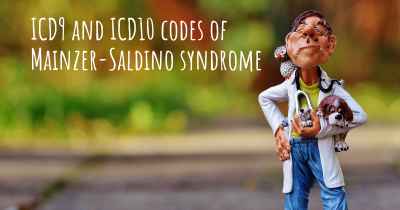What is the history of Mainzer-Saldino syndrome?
When was Mainzer-Saldino syndrome discovered? What is the story of this discovery? Was it coincidence or not?

Mainzer-Saldino syndrome, also known as Mainzer-Saldino-Mohr syndrome, is a rare genetic disorder that affects multiple organ systems in the body. It was first described by German pediatricians Mainzer and Saldino in 1971, and later Mohr in 1973. The syndrome is characterized by a combination of skeletal abnormalities, kidney dysfunction, retinal degeneration, and other associated features.
Skeletal abnormalities: Individuals with Mainzer-Saldino syndrome often exhibit various skeletal abnormalities, including short stature, abnormal curvature of the spine (scoliosis), and abnormalities in the bones of the hands and feet. These skeletal manifestations can vary in severity and may contribute to the physical limitations experienced by affected individuals.
Kidney dysfunction: One of the hallmark features of Mainzer-Saldino syndrome is kidney dysfunction. This can present as renal failure, impaired kidney function, or the presence of cysts in the kidneys. The severity of kidney involvement can vary, and it may lead to the need for renal replacement therapy, such as dialysis or kidney transplantation.
Retinal degeneration: Another significant feature of Mainzer-Saldino syndrome is progressive retinal degeneration, which can lead to visual impairment or blindness. The retinal degeneration typically begins in childhood and worsens over time. It is caused by the progressive loss of photoreceptor cells in the retina, leading to impaired vision.
Additional features that may be associated with Mainzer-Saldino syndrome include intellectual disability, liver abnormalities, heart defects, hearing loss, and abnormalities in the genitalia. The specific combination and severity of these features can vary among affected individuals.
Mainzer-Saldino syndrome is inherited in an autosomal recessive manner, meaning that an individual must inherit two copies of the mutated gene (one from each parent) to develop the condition. The syndrome is caused by mutations in genes involved in the development and function of cilia, which are tiny, hair-like structures found on the surface of cells. Cilia play essential roles in various cellular processes, including cell signaling and movement.
Since its initial description, several cases of Mainzer-Saldino syndrome have been reported in the medical literature. Researchers have identified mutations in multiple genes associated with the syndrome, including IFT140, WDR19, and CEP290. These genes are involved in the formation and maintenance of cilia, and their dysfunction disrupts normal cellular processes, leading to the characteristic features of Mainzer-Saldino syndrome.
Diagnosis of Mainzer-Saldino syndrome is typically based on clinical features, such as skeletal abnormalities, kidney dysfunction, and retinal degeneration. Genetic testing can confirm the diagnosis by identifying mutations in the associated genes. Prenatal testing is also available for families with a known history of the syndrome.
Management of Mainzer-Saldino syndrome is primarily supportive and aims to address the specific symptoms and complications experienced by affected individuals. This may involve regular monitoring of kidney function, interventions to manage skeletal abnormalities, and visual aids to assist with visual impairment. Genetic counseling is essential for affected individuals and their families to understand the inheritance pattern and the risk of passing the syndrome to future generations.
In conclusion, Mainzer-Saldino syndrome is a rare genetic disorder characterized by skeletal abnormalities, kidney dysfunction, retinal degeneration, and other associated features. It was first described by Mainzer and Saldino in 1971 and later Mohr in 1973. The syndrome is caused by mutations in genes involved in cilia function. Diagnosis is based on clinical features and confirmed through genetic testing. Management is supportive and focuses on addressing specific symptoms and complications. Further research is needed to better understand the underlying mechanisms and develop targeted therapies for this complex syndrome.








